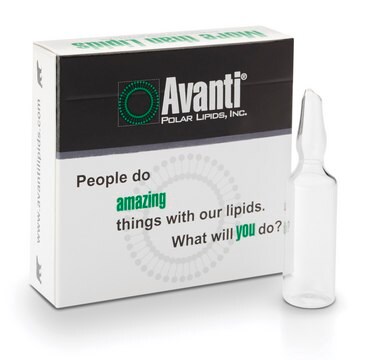890820P
Avanti
18:0 DAP
Avanti Research™ - A Croda Brand 890820P, powder
Synonym(s):
1,2-distearoyl-3-dimethylammonium-propane
Sign Into View Organizational & Contract Pricing
All Photos(1)
About This Item
Empirical Formula (Hill Notation):
C41H81NO4
CAS Number:
Molecular Weight:
652.09
UNSPSC Code:
12352211
NACRES:
NA.25
Recommended Products
form
powder
packaging
pkg of 1 × 25 mg (890820P-25mg)
manufacturer/tradename
Avanti Research™ - A Croda Brand 890820P
lipid type
transfection
cationic lipids
shipped in
dry ice
storage temp.
−20°C
SMILES string
[H]C(CN(C)C)(OC(CCCCCCCCCCCCCCCCC)=O)COC(CCCCCCCCCCCCCCCCC)=O
Application
1,2-distearoyl-3-dimethylammonium-propane (18:0 DAP) might be used to formulate lipid nanoparticles (LNPs) and to test its efficiency of packaging mRNA into an LNP. It might also be used in the preparation of “bubble liposomes” (BLs).
Biochem/physiol Actions
1,2-distearoyl-3-dimethylammonium-propane (18:0 DAP) is a cationic lipid and serves as a pH-sensitive transfection reagent.
Packaging
5 mL Clear Glass Sealed Ampule (890820P-25mg)
Legal Information
Avanti Research is a trademark of Avanti Polar Lipids, LLC
Storage Class Code
11 - Combustible Solids
WGK
WGK 3
Certificates of Analysis (COA)
Search for Certificates of Analysis (COA) by entering the products Lot/Batch Number. Lot and Batch Numbers can be found on a product’s label following the words ‘Lot’ or ‘Batch’.
Already Own This Product?
Find documentation for the products that you have recently purchased in the Document Library.
Yoko Endo-Takahashi et al.
Biomaterials, 34(11), 2807-2813 (2013-01-25)
We have developed polyethyleneglycol (PEG)-modified liposomes (Bubble liposomes; BLs) that entrap ultrasound (US) contrast gas, and we have reported that the combination of BLs and US exposure was an effective tool for delivering pDNA and siRNA in vitro and in
Siddharth Patel et al.
Journal of controlled release : official journal of the Controlled Release Society, 303, 91-100 (2019-04-16)
Retinal gene therapy has had unprecedented success in generating treatments that can halt vision loss. However, immunogenic response and long-term toxicity with the use of viral vectors remain a concern. Non-viral vectors are relatively non-immunogenic, scalable platforms that have had
Our team of scientists has experience in all areas of research including Life Science, Material Science, Chemical Synthesis, Chromatography, Analytical and many others.
Contact Technical Service








